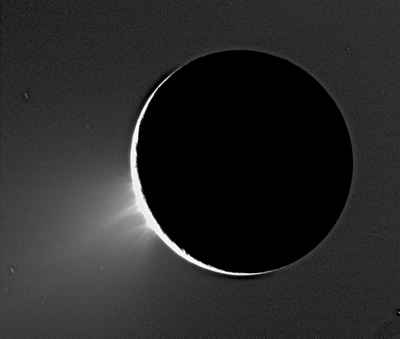The international spacecraft Cassini has visually documented evidence of geological activity on Enceladus - a moon of Saturn

Recent images taken by the spacecraft show thin, icy, feather-like currents rising from the south pole of the moon, which may indicate the presence of hot areas on the ground, from which the currents erupted. The discovery places Enceladus in the status of a geologically active moon alongside Io, a moon of Jupiter, and Triton, a moon of Neptune.
It is not known what causes the geological activity, but scientists believe it is due to internal heating caused by radioactive or tidal activity on the moon's surface.
Cassini passed through the plume-like region that extends about 500 km above Enceladus' surface in July. During the flight, instrumentation on the spacecraft measured the structure of the material and detected water vapor and ice particles.
"The finding brought astonishment, and it is certainly one of the more exciting results" declares Carolyn Furco, head of the imaging team at the Institute of Space Sciences in Boulder, Colorado. Findings and conclusions were presented at the American Geophysical Union conference in San Francisco.
The Cassini-Huygens mission is a joint project of NASA and the European Space Agency (ESA). The combined ship was launched in 1997 and entered satellite orbit around Saturn last year. Huygens, a research satellite developed and controlled by the European Space Agency, landed on the large moon Titan in January of this year.
Ice-spewing volcanoes on Enceladus
By: Avi Blizovsky
Recent images taken by the Cassini spacecraft show the moon Enceladus backlit by the sun, and thus fountain-like emission sources can be seen, spewing fine materials rising above the South Pole region.
The photo was taken from the wide side of a structure known as the "tiger stripe" which was also seen in previous photographs. In the picture you see discontinuous transitions of materials of various sizes above the edge of the moon.
The moon Enceladus is very strange, the researchers admitted
Observations by the Cassini spacecraft on Saturn's moon Enceladus revealed that its south pole is hotter than the rest of its regions and is shooting jets of water vapor into space.
9.9.2005
The moon Enceladus, which orbits the planet Saturn, is a block of ice with a diameter of 500 km. It has an atmosphere and a "hot spot" at its south pole, and it shoots water vapor into space at a rate of about half a ton per second.
The discovery of such features in a celestial body apparently too small for its core to be hot greatly amazed a group of European and American scientists. They admitted this when they published last week the latest data collected by the "Cassini" spacecraft as part of its mission to study Saturn and its moons.
Cassini, a spacecraft about the size of a small bus, was launched in 1997. It arrived at Saturn in July 2004, after a flight of three billion km. In January, Cassini landed a European lander on Titan, Saturn's mysterious moon (which has an atmosphere denser than Earth's).
Cassini then flew past other moons of Saturn. It passed by Enceladus in February and March, and each time its instruments picked up strange behavior of the small moon's magnetic field.
In July, Cassini passed within 175 km of Enceladus and captured clear evidence of the existence of an atmosphere, containing water vapor, carbon dioxide and organic chemicals, above the moon's south pole. She also discovered signs that the surface of the moon at its south pole is warmer and younger than its equatorial and northern hemisphere regions.
The equatorial region was found to be scarred with ancient craters - evidence that it has not changed for billions of years - while the South Pole region has parallel fissures, similar to those on the surface of the Earth's glaciers, and is strewn with blocks of ice the size of houses.
"It must be remembered that Enceladus is quite small, so its gravity is not great," said Michelle Doherty from Imperial College London. "If there is an atmosphere there, you would expect it to disappear quite easily from the face of the moon."
Researchers have no idea why Enceladus, which is mostly minus 200 degrees Celsius, developed a warmer (but still very cold) region at the south pole. This may be evidence that tidal forces are squeezing the moon as it moves in its elliptical orbit around Saturn. It is also possible that it is residual heat from the decay of radioactive elements in the moon's core. The gases may be released into the atmosphere in eruptions from the South Pole.
The researchers believe that the amount of water released from the moon was even enough to form one of Saturn's thinner rings.
"The difficult part to digest is the existence of a heat source on Enceladus that is capable of operating for four billion years," said John Spencer of the Southwest Research Institute in Boulder, Colorado. Caroline Forko of the Boulder Space Science Institute, who heads the imaging team for the Cassini mission, said that "it's just one of Saturn's mysterious moons, and we now have a bird's-eye view of it."

4 תגובות
Everything is a sin